1998 PONTIAC GRAND PRIX air condition
[x] Cancel search: air conditionPage 165 of 402

Hot Weather Example: When you start the vehicle in
hot weather, 80°F (27°C) or after being parked during
the day in full sun, if your Driver Set Temperature is
73°F (23°C) and you are in Full Automatic mode, the
system will automatically move the temperature doors to
full cold. The blower will be at low speed momentarily
and then to the high speed. The
air intake will be
recirculated for maximum cooling performance. As the
interior of the vehicle cools down to your desired
comfort point, the blower will decrease and the
temperature door will move to a warmer position to maintain your desired comfort.
As the cabin cools down
or the sun load decreases the system could switch to
air
delivered to A/C vents and the floor (Bi-level mode).
Manual Control
Fan Buttons
The fan buttons select the amount of air you want when
the system is not in AUTO. The display will show the
fan speed by illuminating a maximum
of seven fan bars.
Mode Button
The center panel has several settings to control the
direction of airflow when the system is not in AUTO.
The indicator light on the button will glow when the
button
is pressed. To access the various modes available,
continue to press the MODE button until the desired
mode appears on the display.
If you prefer to manually control the heating, cooling
and ventilation
in your vehicle, push UPPER, BI-LEV,
LOWER, DEFOG or DEE AUTO will go off the
display. Set
the system to the temperature and fan speed
you want. The system will
try to maintain the
temperature you set using the mode you select.
The
following suggestions will help the system run more
efficiently in manual mode.
RECIRC: This setting recirculates much of the
air inside your vehicle and sends it through the
instrument panel outlets. The
air conditioning
compressor will run automatically in
this setting unless
the outside temperature is below 38°F (3.3"C).
Page 166 of 402

+*
/J UPPER: This setting brings in the outside air and
directs it through the instrument panel outlets.
'# BI-LEV: This setting brings in the outside air and
directs it two ways. Half of the air is directed through
the instrument panel outlets. Most of the remaining air
is
directed through the floor ducts and a little to the defrost
and side window vents.
LOWER: This setting sends most of the air
through the ducts near the floor. The remaining airflow
comes out of
the defroster and side window vents.
+e
w
DEFOG: This setting allows half of the air to go
to the floor ducts and half to the defroster and side
window vents.
DEF: This setting directs most of the air through
the defrost vent. Some of the air goes
to the floor ducts
and the side window vents. The air conditioning
compressor will
run automatically in this setting unless
the outside temperature is below 38°F (3.3"C).
Air Conditioning
On very hot days, open the windows long enough to let
hot, inside
air escape. This reduces the time for the
vehicle to cool down.
For quick cool-down on very hot days, use
RECIRC. If
this setting is used for long periods of time, the air in
your vehicle may become too
dry.
For normal cooling on hot days, use UPPER with the
A/C button pushed in. The system will bring in outside
air and cool it.
On cool, but sunny days, the sun may warm your upper
body, but
your lower body may not be warm enough.
You can use
BI-LEV with the A/C button pushed in.
The system will bring in outside air and direct it to your
upper body, while sending slightly warmed
air to your
lower body. You may notice this temperature difference
more at some times than others.
3-7
Page 167 of 402
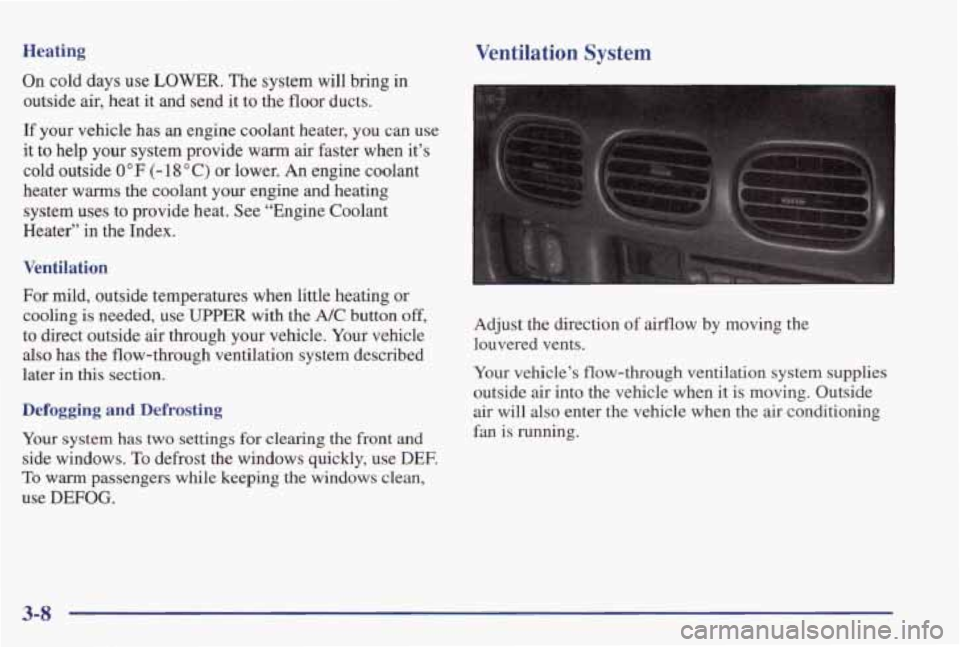
Heating Ventilation System
On cold days use LOWER. The system will bring in
outside
air, heat it and send it to the floor ducts.
If your vehicle has
an engine coolant heater, you can use
it to help
your system provide warm air faster when it’s
cold outside
0°F (- 18°C) or lower. An engine coolant
heater
warms the coolant your engine and heating
system uses to provide heat. See “Engine Coolant
Heater” in the Index.
Ventilation
For mild, outside temperatures when little heating or
cooling is needed, use
UPPER with the A/C button off,
to direct outside air through your vehicle. Your vehicle
also has the flow-through ventilation system described
later in this section.
Defogging and Defrosting
Your system has two settings for clearing the front and
side windows. To defrost the windows quickly, use DEE
To warm passengers while keeping the windows clean,
use
DEFOG.
Adjust the direction of airflow by moving the
louvered vents.
Your vehicle’s flow-through ventilation system supplies
outside
air into the vehicle when it is moving. Outside
air will also enter the vehicle when the
air conditioning
fan is running.
3-8
Page 184 of 402

To eject the magazine from the player, slide the CD
changer door
all the way open. The magazine will
automatically eject. Remember to keep the door closed
whenever possible to keep dirt and dust from getting
inside the changer.
All of the CD functions are controlled by the radio
buttons except for ejecting the magazine. Whenever
a
CD magazine with discs is loaded in the changer, the
compact
disc symbol will appear on the radio display. If
the CD changer is checking the magazine for CDs, the
compact disc symbol will flash on the display until the
changer is ready to play. When a CD begins playing, CD
will appear in the bottom left corner and a disc and track
number will be displayed. The disc numbers are listed
on
the front of the magazine.
Compact Disc Errors
If E and a number appear on the display, an error has
occurred and the compact disc temporarily cannot play.
The CD changer will send
an error message to the
receiver to indicate: If
the error occurred while trying to play a CD in the
compact disc player or changer, the following conditions
may have caused the error:
0 The road is too rough. The disc should play when the
0 The disc is dirty, scratched or wet.
The disc is label side up. If so, load the disc label
The air is very humid. If so, wait about an hour and
0 The CD changer door is open. Completely close the
An empty magazine is inserted in the CD changer.
road
is smoother.
side down.
try again.
door to restore normal operation.
Try the magazine again with a disc loaded on one of
the trays.
If any error occurs repeatedly or
if an error cannot be
corrected, please contact your dealer.
If your radio
displays an error number, write it down and provide it to
your dealer when reporting the problem.
I'
0 E30: Disc Label Side Up
0 E34: CD Changer Door Open
0 E35: CD Changer Cartridge Empty
3-25
Page 191 of 402
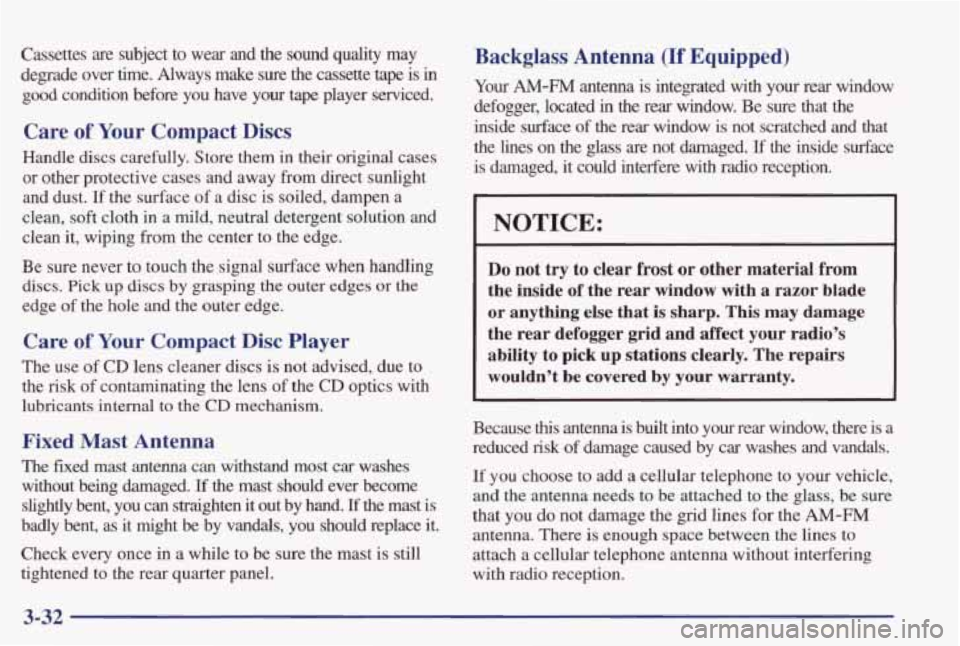
Cassettes are subject to wear and the sound quality may
degrade over time. Always make sure the cassette
tape is in
good condition before you have your tape player serviced.
Care of Your Compact Discs
Handle discs carefully. Store them in their original cases
or other protective cases and away from direct sunlight and dust.
If the surface of a disc is soiled, dampen a
clean,
soft cloth in a mild, neutral detergent solution and
clean it, wiping from the center to the edge.
Be sure never to touch the signal surface when handling
discs. Pick up discs by grasping the outer edges or the
edge of the hole and the outer edge.
Care of Your Compact Disc Player
The use of CD lens cleaner discs is not advised, due to
the risk
of contaminating the lens of the CD optics with
lubricants internal to the
CD mechanism.
Fixed Mast Antenna
The fixed mast antenna can withstand most car washes
without being damaged.
If the mast should ever become
slightly bent, you can straighten it out by hand. If the mast is
badly bent,
as it might be by vandals, you should replace it.
Check every once in a while to be sure the mast is still
tightened to the rear quarter panel.
Backglass Antenna (If Equipped)
Your AM-FM antenna is integrated with your rear window
defogger, located
in the rear window. Be sure that the
inside surface of the rear window is not scratched and that
the lines
on the glass are not damaged. If the inside surface
is damaged, it could interfere
with radio reception.
NOTICE:
Do not try to clear frost or other material from
the inside
of the rear window with a razor blade
or anything else that is sharp. This may damage
the rear defogger
grid and affect your radio’s
ability to pick
up stations clearly. The repairs
wouldn’t be covered
by your warranty.
Because this antenna is built into your rear window, there is a
reduced risk of damage caused by car washes and vandals.
If you choose to add a cellular telephone to your vehicle,
and
the antenna needs to be attached to the glass, be sure
that you
do not damage the grid lines for the AM-FM
antenna. There is enough space between the lines to
attach a cellular telephone antenna without interfering
with radio reception.
3-32
Page 210 of 402
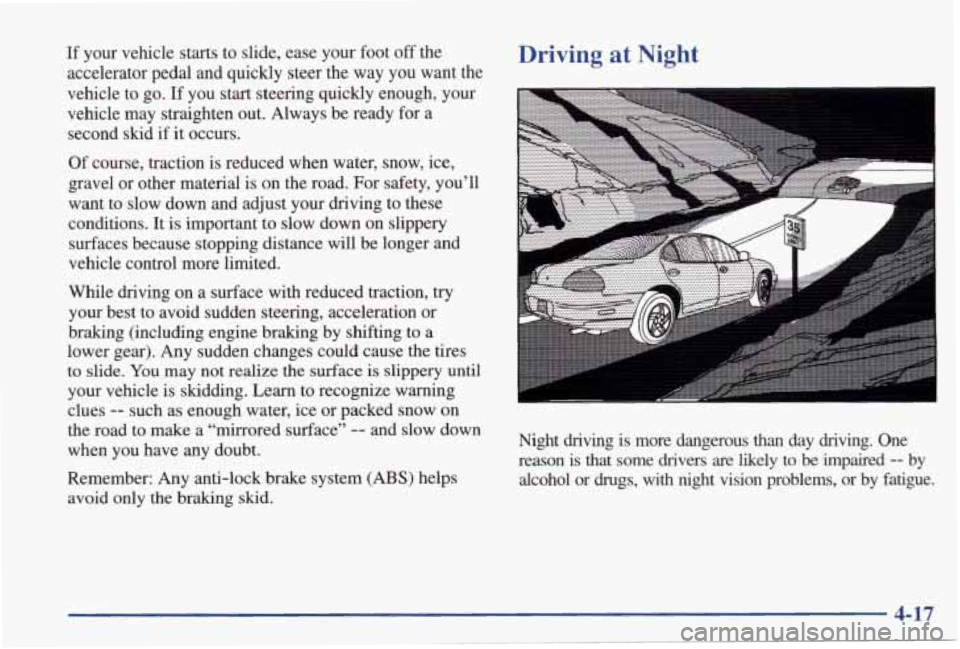
If your vehicle starts to slide, ease your foot off the
accelerator pedal and quickly steer the way you want the
vehicle to go.
If you start steering quickly enough, your
vehicle may straighten out. Always be ready for a
second skid
if it occurs.
Of course, traction is reduced when water, snow, ice,
gravel or other material is on the road. For safety, you’ll
want to slow down and adjust your driving to these
conditions. It
is important to slow down on slippery
surfaces because stopping distance will be longer and
vehicle control more limited.
While driving
on a surface with reduced traction, try
your best to avoid sudden steering, acceleration or
braking (including engine braking by shifting to a
lower gear). Any sudden changes could cause the tires
to slide. You may not realize the surface is slippery until
your vehicle is skidding. Learn to recognize warning
clues
-- such as enough water, ice or packed snow on
the road to make a “mirrored surface” -- and slow down
when you have any doubt.
Remember: Any anti-lock brake system
(ABS) helps
avoid only the braking
skid.
Driving at Night
Night driving is more dangerous than day driving. One
reason is that some drivers
are likely to be impaired -- by
alcohol or drugs, with night vision problems, or by fatigue.
4-17
Page 250 of 402
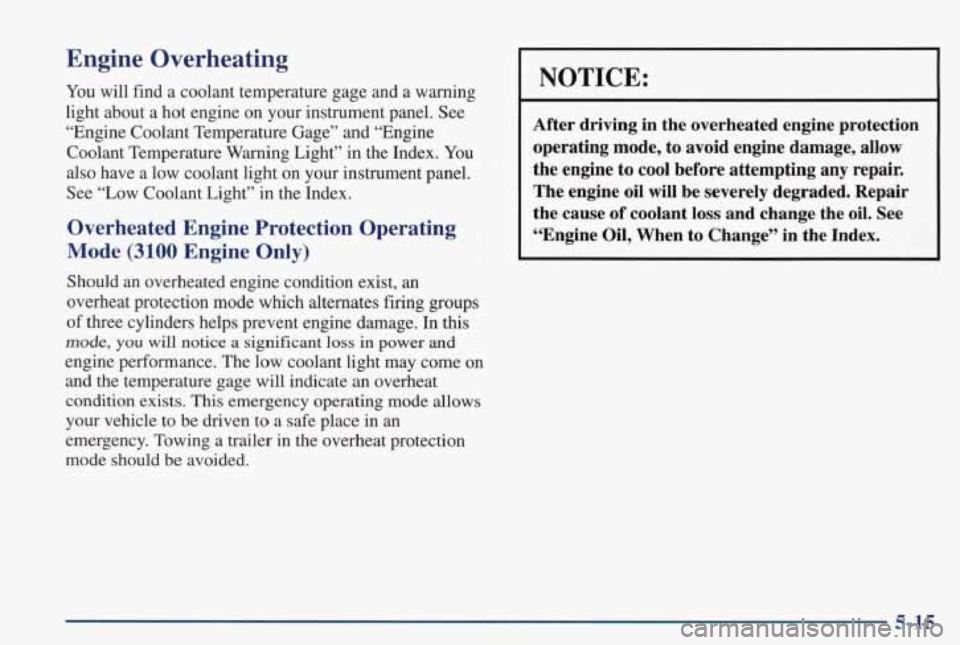
Engine Overheating
You will find a coolant temperature gage and a warning
light about a hot engine on your instrument panel. See
“Engine Coolant Temperature Gage” and “Engine
Coolant Temperature Warning Light” in the Index. You
also have a low coolant light on your instrument panel.
See “Low Coolant Light” in the Index.
Overheated Engine Protection Operating
Mode
(3100 Engine Only)
Should an overheated engine condition exist, an
overheat protection mode which alternates firing groups
of three cylinders helps prevent engine damage. In this
mode, you will notice a significant loss in power and
engine performance. The low coolant light may come on
and the temperature gage will indicate an overheat
condition exists. This emergency operating mode allows
your vehicle to be driven to a safe place in an
emergency. Towing a trailer in the overheat protection
mode should
be avoided.
NOTICE:
After driving in the overheated engine protection
operating mode, to avoid engine damage,
allow
the engine to cool before attempting any repair.
The engine
oil will be severely degraded. Repair
the cause of coolant loss and change the oil. See
“Engine Oil, When to Change” in the Index.
5-15
Page 252 of 402
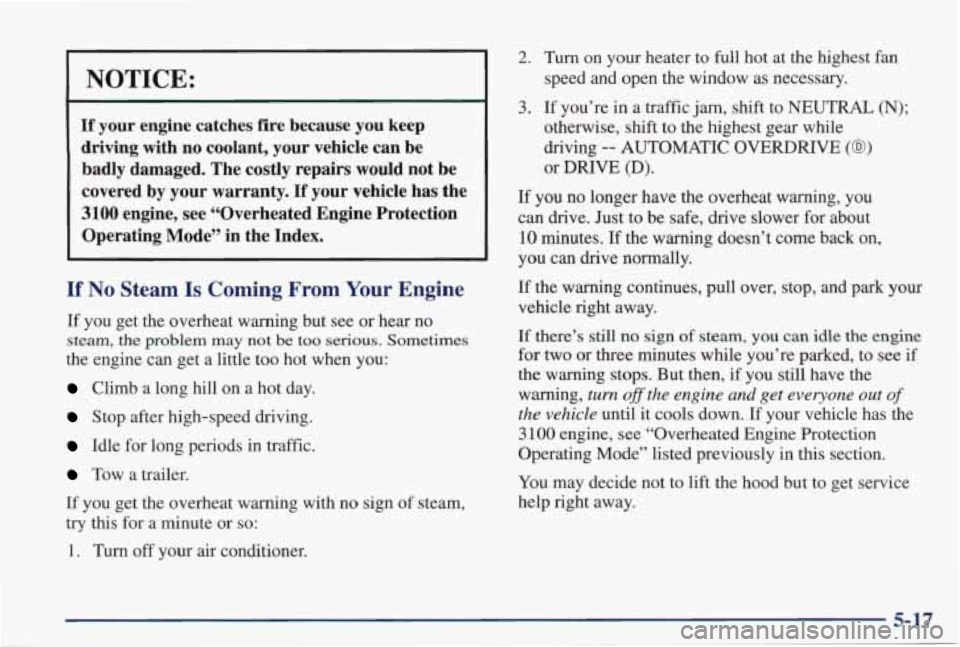
NOTICE:
If your engine catches fire because you keep
driving with no coolant, your vehicle can be
badly damaged. The costly repairs would not be
covered by your warranty.
If your vehicle has the
3100 engine, see “Overheated Engine Protection
Operating Mode” in the Index.
If No Steam Is Coming From Your Engine
If you get the overheat warning but see or hear no
steam, the problem may not be too serious. Sometimes
the engine can get a little too hot when you:
Climb a long hill on a hot day.
Stop after high-speed driving.
Idle for long periods in traffic.
Tow a trailer.
If you get the overheat warning with no sign of steam,
try this for a minute or so:
1. Turn off your air conditioner.
2. Turn on your heater to full hot at the highest fan
speed and open the window as necessary.
3. If you’re in a traffic jam, shift to NEUTRAL (N);
otherwise, shift to the highest gear while
driving
-- AUTOMATIC OVERDRIVE (03)
or DRIVE (D).
If you no longer have the overheat warning, you
can
drive. Just to be safe, drive slower for about
10 minutes. If the warning doesn’t come back on,
you can
drive normally.
If the warning continues, pull over, stop, and park
your
vehicle right away.
If there’s still no sign of steam, you can idle the engine
for two or three minutes while you’re parked, to see if
the warning stops. But then, if you still have the
warning,
turn off the engine and get everyone out of
the vehicle until it cools down. If your vehicle has the
3 100 engine, see “Overheated Engine Protection
Operating Mode” listed previously in this section.
You may decide not to lift the hood but to get service
help right away.
5-17